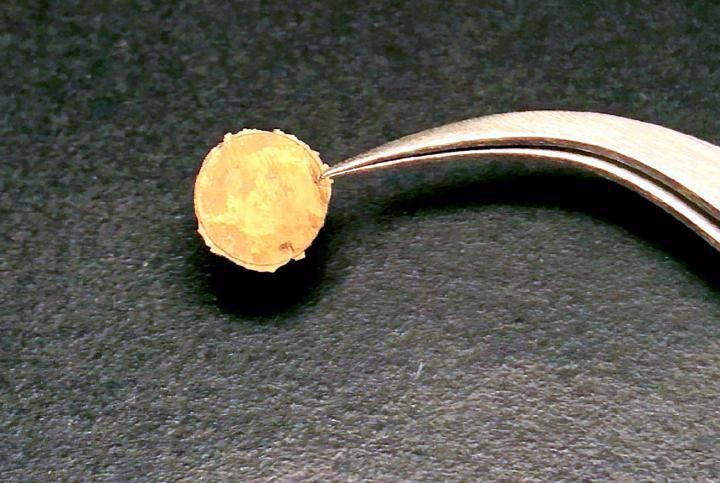Jan 25 2021
Metallurgists have developed different methods to make a chunk of metal harder than before. They can twist it, bend it, pound it with a hammer, or send it between two rollers.
 This gold “coin” was made from nanoparticle building blocks, thanks to a new technique developed by Brown University researchers. Making bulk metals this way allows for precise of the metal’s microstructure, which enhances its mechanical properties. Image Credit: Chen Lab/Brown University.
This gold “coin” was made from nanoparticle building blocks, thanks to a new technique developed by Brown University researchers. Making bulk metals this way allows for precise of the metal’s microstructure, which enhances its mechanical properties. Image Credit: Chen Lab/Brown University.
In these methods, the grain structure of the metal is broken up. Grain structure constitutes the microscopic crystalline domains forming a bulk piece of metal, where harder metals have smaller grains.
A team of researchers from Brown University has now discovered to customize metallic grain structures from the scratch. They demonstrated a technique for smashing individual metal nanoclusters together to create solid macro-scale hunks of solid metal. The study results have been described in a paper published in the journal Chem.
Metals manufactured with this technique were mechanically tested, revealing that they were nearly four times harder compared to metal structures that occur naturally.
Hammering and other hardening methods are all top-down ways of altering grain structure, and it’s very hard to control the grain size you end up with. What we’ve done is create nanoparticle building blocks that fuse together when you squeeze them. This way we can have uniform grain sizes that can be precisely tuned for enhanced properties.
Ou Chen, Assistant Professor of Chemistry, Brown University
Chen is the corresponding author of the new study, for which the researchers developed centimeter-scale “coins” with nanoparticles of gold, palladium, silver, and other metals.
Items of this size could be helpful to make high-performance coating materials, thermoelectric generators (devices that transform heat fluxes into electricity), or electrodes. However, the researchers consider that the process could be scaled up easily to create larger industrial components or super-hard metal coatings.
According to Chen, the chemical treatment of the nanoparticle building blocks is crucial to this process. Metal nanoparticles are usually covered with organic molecules known as ligands. These molecules often inhibit the formation of metal-metal bonds between particles. Chen and his colleagues discovered a method to remove the ligands chemically, thereby enabling the clusters to fuse together with minimal pressure.
The metal coins formed using this method were considerably harder compared to standard metal, the study demonstrated. For instance, the gold coins were two to four times harder than usual. Other characteristics such as light reflectance and electrical conduction were almost equal to that of standard metals, found the team.
Chen noted that gold coins exhibited remarkable optical properties, as there was a drastic change in color upon compressing the nanoparticles into bulk metal.
Because of what’s known as the plasmonic effect, gold nanoparticles are actually purplish-black in color. But when we applied pressure, we see these purplish clusters suddenly turn to a bright gold color. That’s one of the ways we knew we had actually formed bulk gold.
Ou Chen, Assistant Professor of Chemistry, Brown University
Chen further added that theoretically, the method could be employed to make metals of any type. Indeed, Chen and his colleagues demonstrated that it is viable to make an exotic form of metal called a metallic glass.
Metallic glasses are amorphous in nature, that is, they lack the regularly repeating crystalline structure of normal metals. That paves the way to fascinating properties. When compared to conventional metals, metallic glasses can be molded more easily, can be considerably stronger and crack-resistant, and display superconductivity at low temperatures.
Making metallic glass from a single component is notoriously hard to do, so most metallic glasses are alloys. But we were able to start with amorphous palladium nanoparticles and use our technique to make a palladium metallic glass.
Ou Chen, Assistant Professor of Chemistry, Brown University
Chen believes that the method could someday be used extensively for commercial products. The chemical treatment used on the nanoclusters is much simple, and the pressures applied to compress them together are well within the range of standard industrial equipment. Chen has obtained patents for the technique and hopes to continue analyzing it.
“We think there’s a lot of potential here, both for industry and for the scientific research community,” concluded Chen.
Chen’s co-authors on the study were Yasutaka Nagaoka, Masayuki Suda, Insun Yoon, Na Chen, Hanjun Yang, Yuzi Liu, Brendan A. Anzures, Stephen W. Parman, Zhongwu Wang, Michael Grünwald, and Hiroshi M. Yamamoto. The study was funded by the National Science Foundation (CMMI-1934314, DMR-1332208, DMR-1848499) and the U.S. Department of Energy (DE-AC02-06CH11357).
Journal Reference:
Nagaoka, Y., et al. (2021) Bulk Grain-Boundary Materials from Nanocrystals. Chem. doi.org/10.1016/j.chempr.2020.12.026.